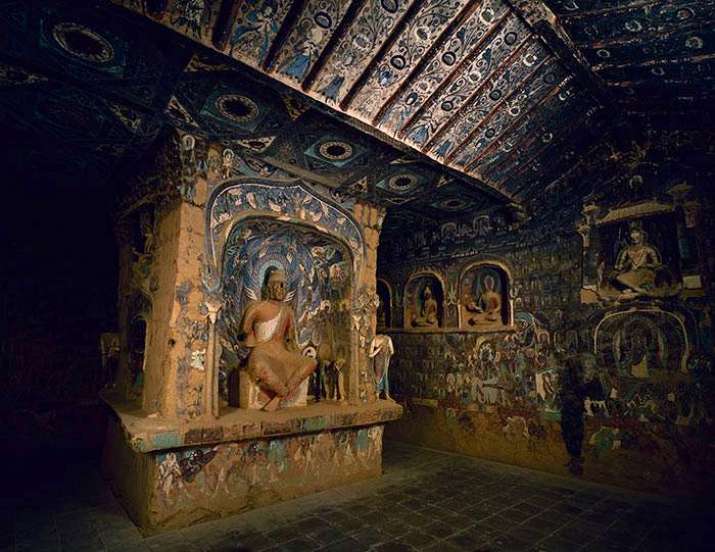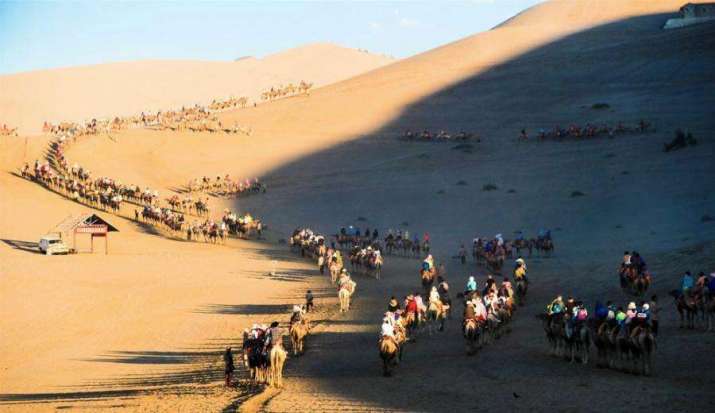NEWS
English Version of Digital Dunhuang Offers Virtual Tour of Mogao Caves
 Mogao Cave 254. From e-dunhuang.com
Mogao Cave 254. From e-dunhuang.comDunhuang Research Academy, which is responsible for the conservation, management, and research of the historic Buddhist site known as the Moagao Caves recently announced the official launch of the English-language version of Digital Dunhuang, a remarkable website offering scholars, Buddhists, and anyone with an interest in Buddhist history, art, and culture online access to a 360-degree virtual tour of the ancient grottoes.
The famed caves, an ancient network of Buddhist grottoes and temples hewn into the side of a sandstone cliff in the Gobi Desert, are a repository of some of the finest and oldest works of Buddhist art in China. A UNESCO World Heritage Site since 1987, the Mogao Caves, also known as the Thousand Buddha Grottoes, include some 492 Buddhist temples dating from the 4th to the 14th centuries, decorated with more than 45,000 square meters of exquisite frescoes and some 2,000 sculptures. During the period that the area served as a strategic oasis and major crossroads on the ancient Silk Road, the caves were visited by countless travelers, merchants, and Buddhist pilgrims, and are now more popular than ever.
The ongoing project is the outcome of more than 20 years of work digitizing the caves and their contents, Digital Dunhuang offers access to 30 grottoes that date to as early as the Northern Wei dynasty (386–535) that ruled what is now northern China, through high-definition images and video that also take advantage of virtual reality technologies. The Dunhuang Research Academy has so far completed digitalizing frescoes in 150 caves, exceeding 300 TB of data. This is projected to increase as the work continues. More than 120 scholars and artists from Brazil, Britain, China, France, Hong Kong, Italy, Japan, South Korea, Taiwan, and the United States attended a launch ceremony for resource in late September.
 Mogao Cave 285. from e-dunhuang.com
Mogao Cave 285. from e-dunhuang.comVisitors to the site can choose which caves they wish to explore, and navigate the grottoes and passageways in real time, with the ability to zoom in and examine the Buddhist frescoes and sculptures in high-definition detail. According to a statement from the academy, the Digital Dunhuang website switches automatically to Chinese or English, based on the language setting of the user’s operating system. Visitors can also change their language preference manually.
The first of the Mogao caves was excavated in 366, and the site was developed and expanded over the next 1,000 years. The 735 caves hold more than 2,400 irreplacable works of art that are invaluable in the study of the history of Buddhism and its cultural and social impact in China. The Chinese-language version of the website was launched in 2016.
The project comes in part as a response the the explosion in the number of visitors to the historic site, which reaches up to 25,000 people daily, threatening to irreversibly damage these ancient works of Buddhist art that have survived the vicissitudes of human activity and the elements for centuries. The draw of the caves—located near the city of Dunhuang in northwest Gansu Province—as a tourist attraction has soared in recent years as a result of their growing fame in China and overseas, facilitated by improved transportation links between Dunhuang and other parts of China. Chinese president Xi Jinping’s ambitious economic and trade development initiative known as “One Belt, One Road”—a plan to resurrect the Silk Road for the 21st century—has also served to renew interest in the Silk Road and historic sites along the ancient trade routes.
 Tourists ride camels at a scenic spot near Dunhuang. More than 25,000 people visit Mogao daily during the peak summer period. Photo by Wang Binyin. From ecns.com
Tourists ride camels at a scenic spot near Dunhuang. More than 25,000 people visit Mogao daily during the peak summer period. Photo by Wang Binyin. From ecns.comTaking its name from the lucrative trade in Chinese silk products that was conducted along its length, beginning during the Han dynasty (207 BCE–220 CE), the Silk Road was key to cultural as well as commercial interaction throughout Asia and as far west as the Mediterranean Sea. Trade on the Silk Road was a significant factor in the development of civilizations in China, the Indian subcontinent, Persia, Europe, Africa, and Arabia, and also led to cultural exchanges and the spread of syncretic philosophies and religious thought, including Buddhism, Christianity, and Islam.
See more
Digital Dunhuang
Research institute launches digital tours in English of ancient Buddhist art (Ecns.cn)
Take a tour of NW China's Mogao Grottoes, online and in English (Ecns.com)
Dunhuang tourist site attracts 25,000 visitors daily (Ecns.cn)
English edition of Digital Dunhuang officially launched (China.org.cn)
Related news from Buddhistdoor Global
Dunhuang Airport to Close for Expansion as Popularity of Mogao Caves Takes Off
Record Tourist Numbers Threaten Ancient Buddhist Art in China’s Mogao Caves
Ancient Hygiene Habits Show Silk Road Facilitated Passage of Disease, as Well as Commerce and Buddhism
Archaeological Find Reveals New Silk Road Route
Related features from Buddhistdoor Global
From the Gobi to the Getty: Buddhist Art from Dunhuang on View in Los Angeles
Dance at Dunhuang: Part One
Dance at Dunhuang: Part Two – The Case for the Feitian
Dance at Dunhuang: Part Three - The Sogdian Whirl
Lee Mei-yin holds the keys to a renaissance in appreciating Dunhuang and Buddhist art














